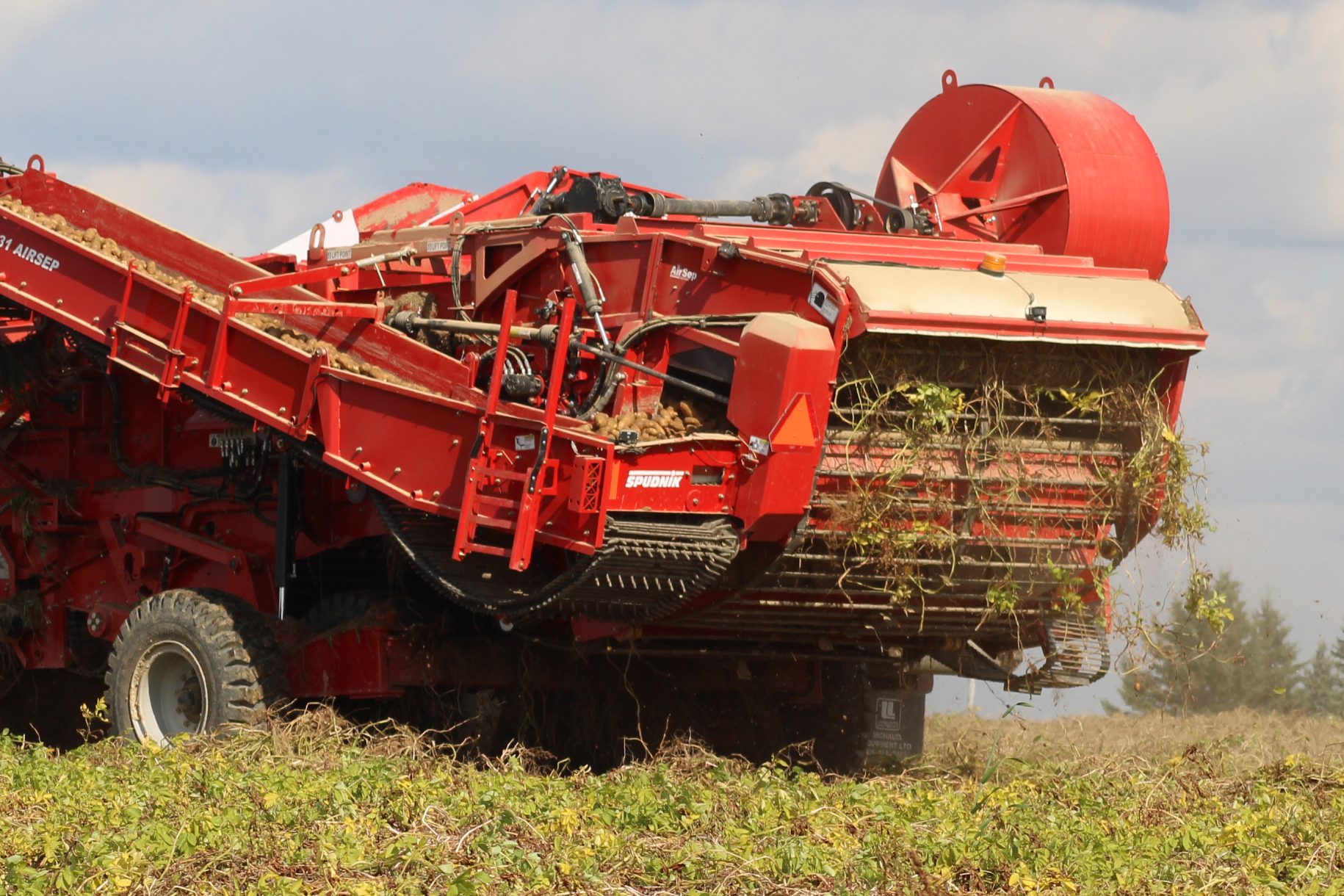
Seeing Canadian potatoes cross the border bound for U.S. markets makes Aroostook County farmers edgy. Right now they have plenty to be edgy about.
Canada is sending more fresh potatoes to U.S. markets, according to Canadian officials.
Between 2020 and 2022, Canadian potato exports to the U.S. increased by 20.8 percent due to a decline in U.S. potato production, said Bronwyn Goodman, communications officer at Agriculture and Agri-Food Canada. U.S. production declined by 2 percent in 2021 and 3 percent in 2022.
Production aside, the current exchange rate has $1 in American currency worth $1.36 in Canadian money. Canada’s weaker dollar helps exporters, because U.S. buyers can get more Canadian potatoes for every dollar they’d spend stateside.
Maine farmers dealt with a season plagued by rain that left some potatoes too wet to harvest. They also faced inflation that raised farming costs. Though some said the crop showed good quality, stifling fears of large losses due to the weather, others say battling cheaper Canadian tubers is slicing into their profits.
“The biggest issue is the Canadian exchange rate. That’s killing us,” Isaac Braley of Green Meadow Farms in Mapleton said. “In New England, the Canadians are hurting us the most.”
Potatoes are Maine’s No. 1 food crop. In 2022, the state produced 1.8 billion pounds of potatoes, valued at $247 million, according to the United States Department of Agriculture.
Potatoes are also the top crop in Prince Edward Island and second in New Brunswick. In 2022, potatoes brought $253 million (in Canadian funds) to Prince Edward Island and $178 million to New Brunswick, according to Agriculture and Agri-Food Canada.
Based on current exchange rates, that’s roughly $186 million in U.S. dollars for Prince Edward Island and $130.8 million for New Brunswick.
Exports from the island province were halted in 2021 due to a potato fungus, and markets leaned more on Maine farmers to supply their needs. That was a good year for local farmers, Braley said. But now, Canadian potatoes are infiltrating Northeast markets because buyers can get them for less.
The situation might bring to mind the historic 1980 protests, when County farmers dumped loads of potatoes at several U.S.-Canadian border sites and picketed to protest cheaper Canadian imports.
Kramer Bell of Bell Farms in Mars Hill doesn’t think it’s quite that dire, but it is an ongoing issue for Maine farmers.
This year Canadian tubers might have slightly better quality because of Maine’s wet growing and harvest season, but the biggest reason Northeastern markets buy Canadian potatoes is the exchange rate, he said.
“I don’t think it’s any more than normal,” he said. “Because of the money difference, for every dollar [a buyer] spends, they’re getting $1.30 [or so] in return. If the money was at par, they would obviously buy the potatoes from here.”
Bell grows 350 acres of potatoes. About half go to processors and half to the fresh market, he said.
Resolving the issue would take some kind of a trade agreement, he said. And it’s not just potato farmers, it’s any product — lobster, forestry products and more. Maine just happens to be close to another country and deals with cross-border trade issues.
The U.S. produced 20.5 million tons of potatoes in 2021 and 19.6 million in 2022, according to the United States Department of Agriculture’s 2022 potato report. Maine ranked 7th and 8th, respectively, among potato producing states, with 919,000 tons in 2021 and 903,000 in 2022.
In 2021, Canada sent nearly 446,000 U.S. tons of fresh and seed potatoes to American markets, Goodman said, referring to data from Statistics Canada. That number jumped in 2022 to 601,000 U.S. tons.
Moneywise, those potatoes were worth $349 million Canadian, or $258 million in U.S. funds, in 2021, and $530 million Canadian or about $392 million U.S. the following year, according to the data.
“The exchange rate impacts individual farmers in Canada and the U.S. differently and will vary depending on the situation of each farm,” Goodman said.
Canadian producers can apply for financial support for marketing, research and environmental sustainability, including climate change, she said. Agriculture and Agri-Food Canada also offers programs to help all agricultural producers deal with risks that threaten their farms, she added.
Maine growers historically have pushed for more federal agriculture subsidies to equal what they perceive as the Canadian government’s generous support of farmers.
“Canada does have a trade advantage regarding the exchange rate, which can make their pricing for all sorts of commodities more attractive to buyers,” said Jim Britt, communications director for the Maine Department of Agriculture, Conservation and Forestry.
The U.S. doesn’t subsize specialty crops like potatoes, but has non-subsidy resources, including state and federal grant and loan programs and federal crop insurance, Britt said.
Representatives from the Maine Potato Board did not return messages seeking comment.
The Maine Legislature this year has addressed various programs to benefit agriculture, including irrigation grants and protecting farmers affected by per- and polyfluoroalkyl substances. There was nothing specific to Canadian potato exports, according to an October report by the Joint Standing Committee on Agriculture, Conservation and Forestry.
The National Potato Council in Washington, D.C., is working on continued measures to prevent potato wart coming into the U.S. from Prince Edward Island, but is not involved in other U.S.-Canadian trade areas, said Director of Communications Mark Szymanski.
Right now, Kramer Bell’s business is on track for a good year, and it hasn’t been difficult to find buyers, he said. Still, he’s concerned about Canadian potatoes filling U.S. market needs.
“A lot of Canadian potatoes come over here every night to go to the Boston market,” he said. “If that avenue was closed to those buyers, they would definitely take more Maine potatoes.”







